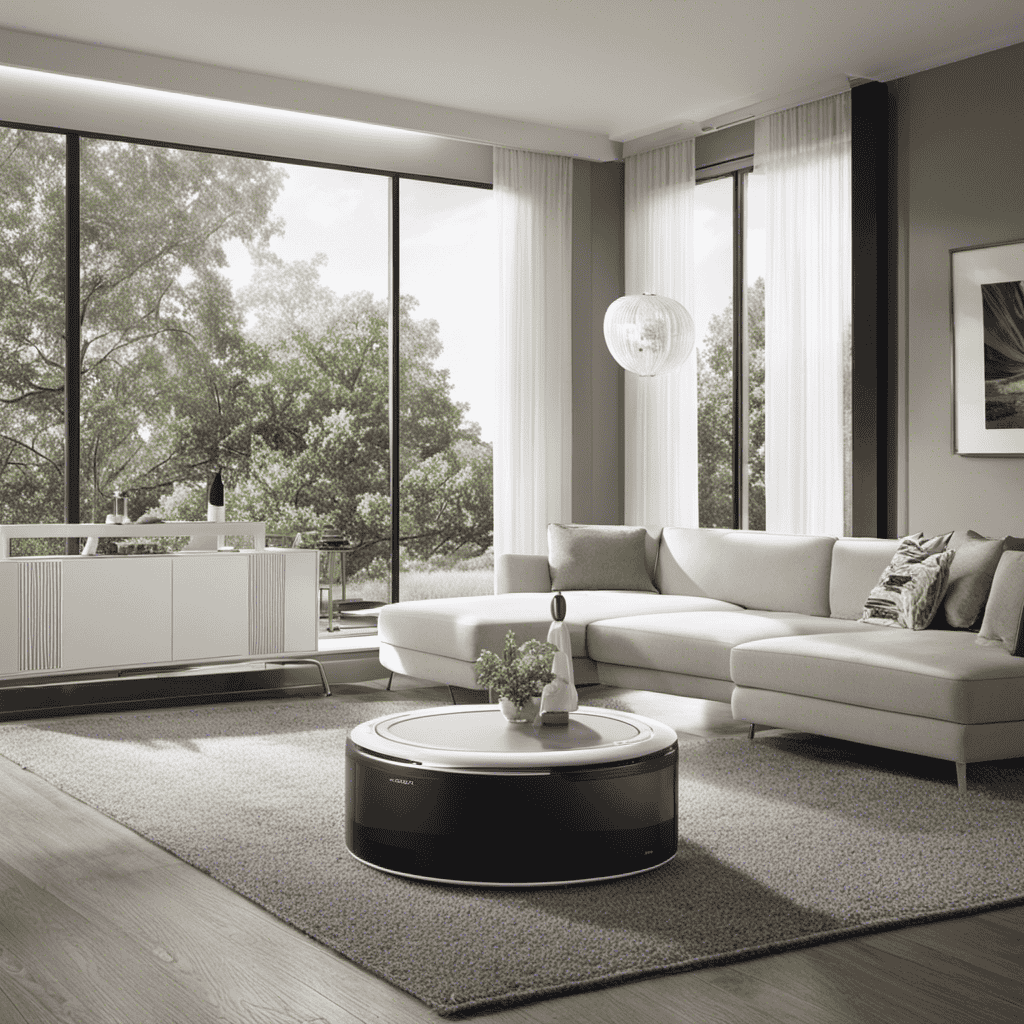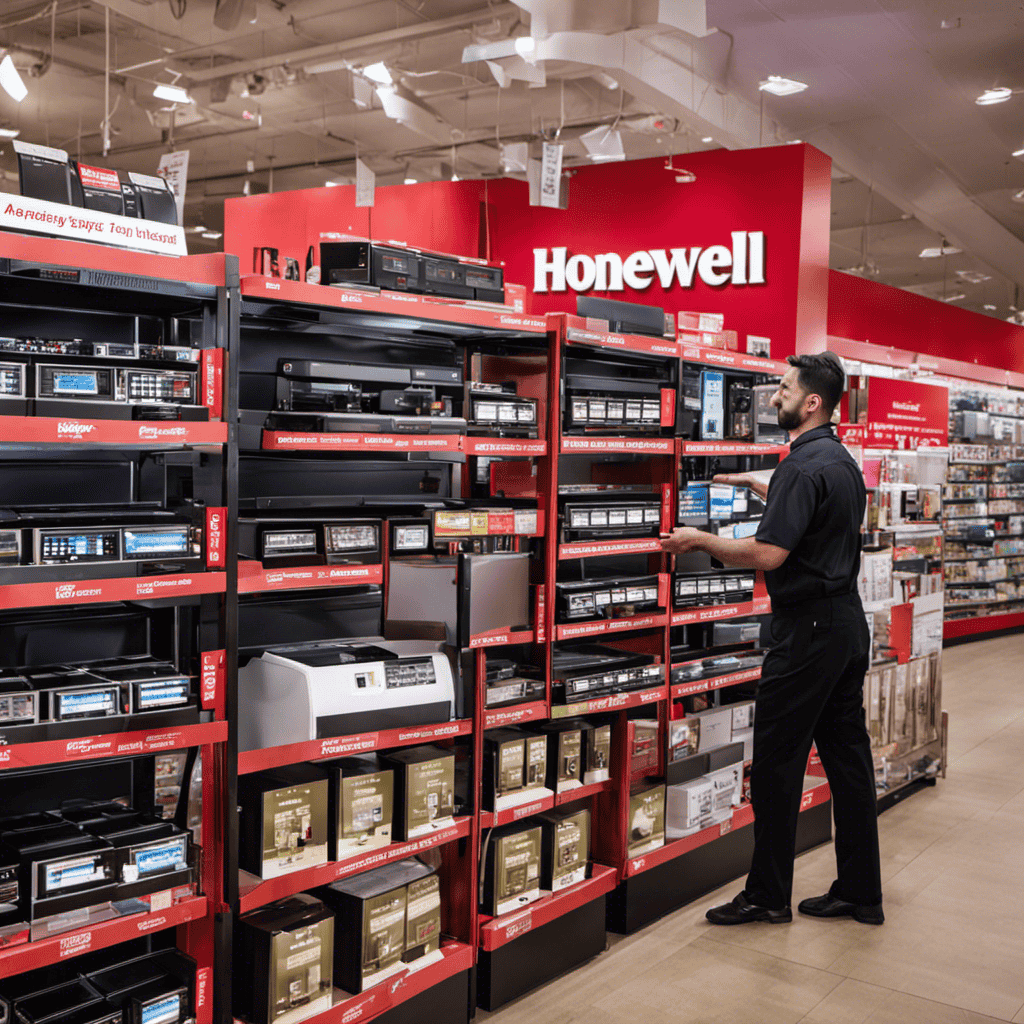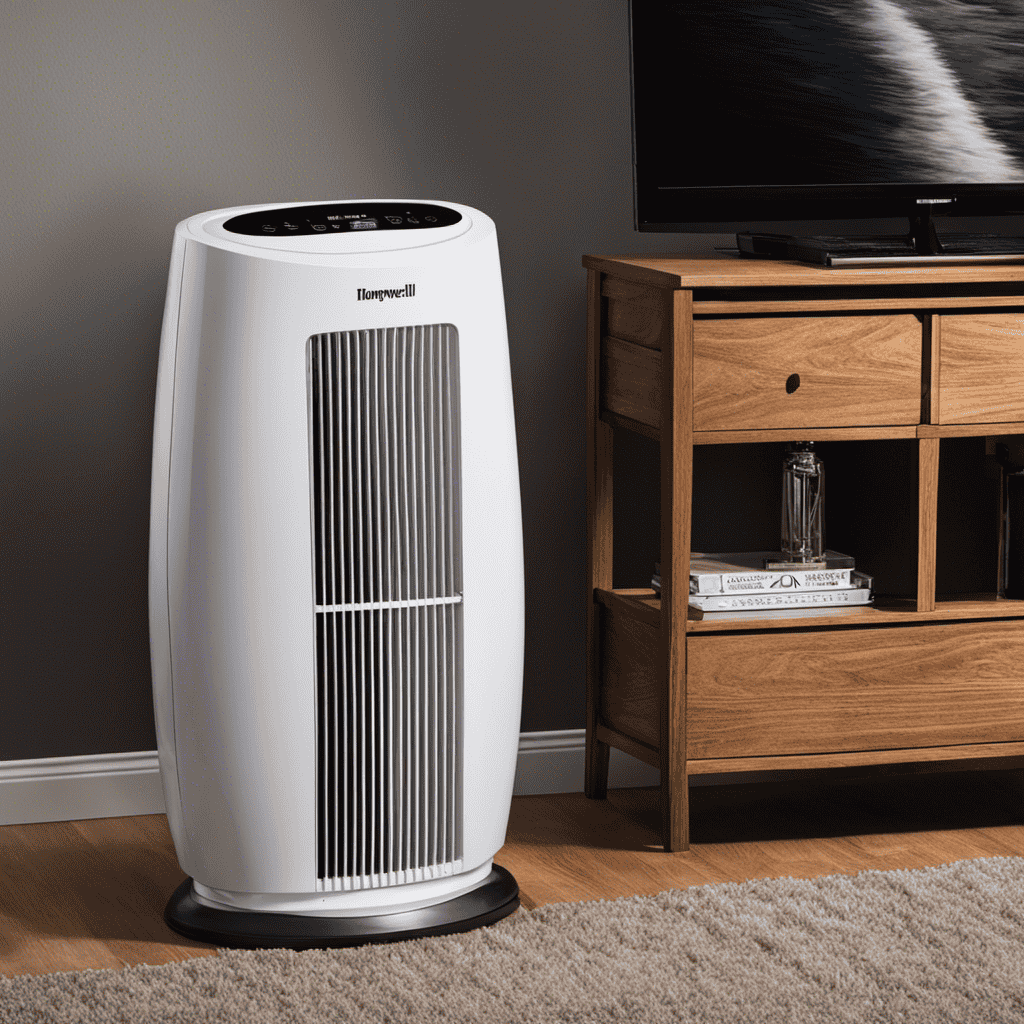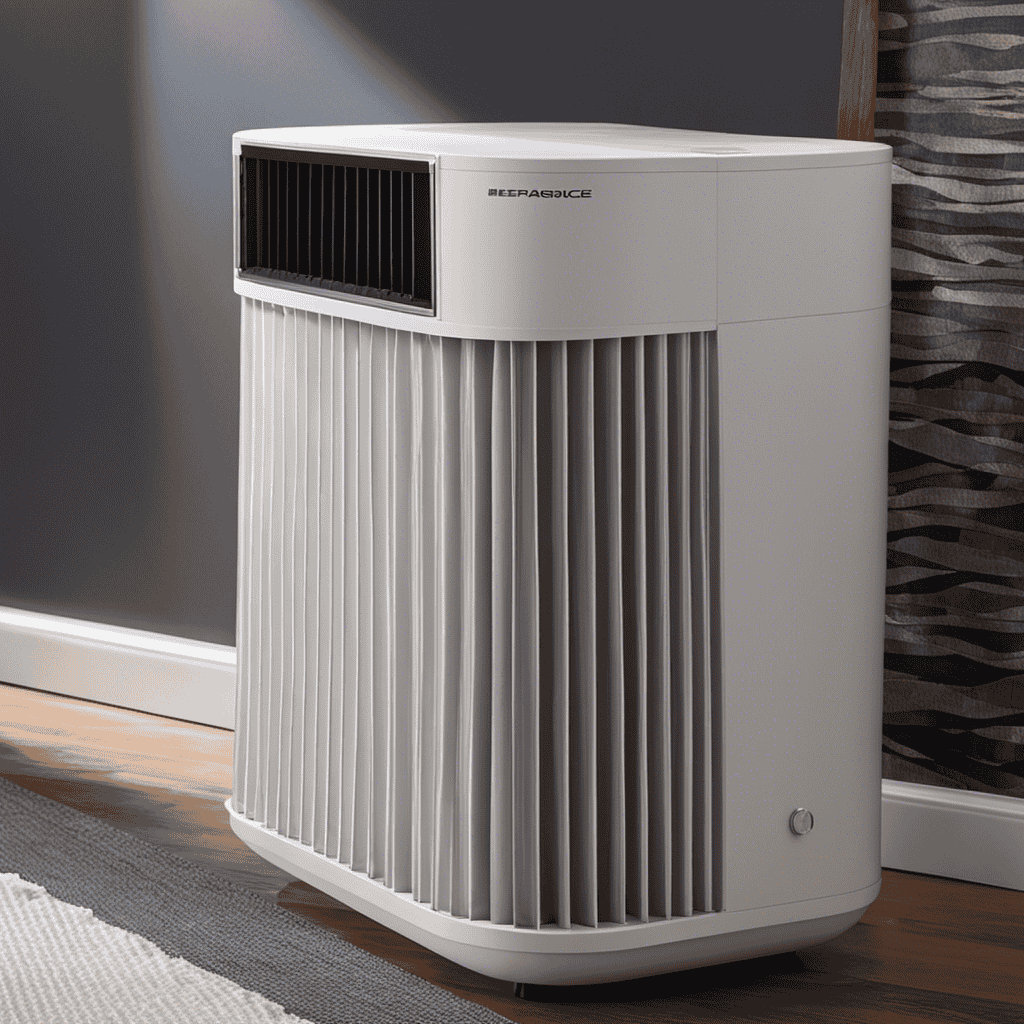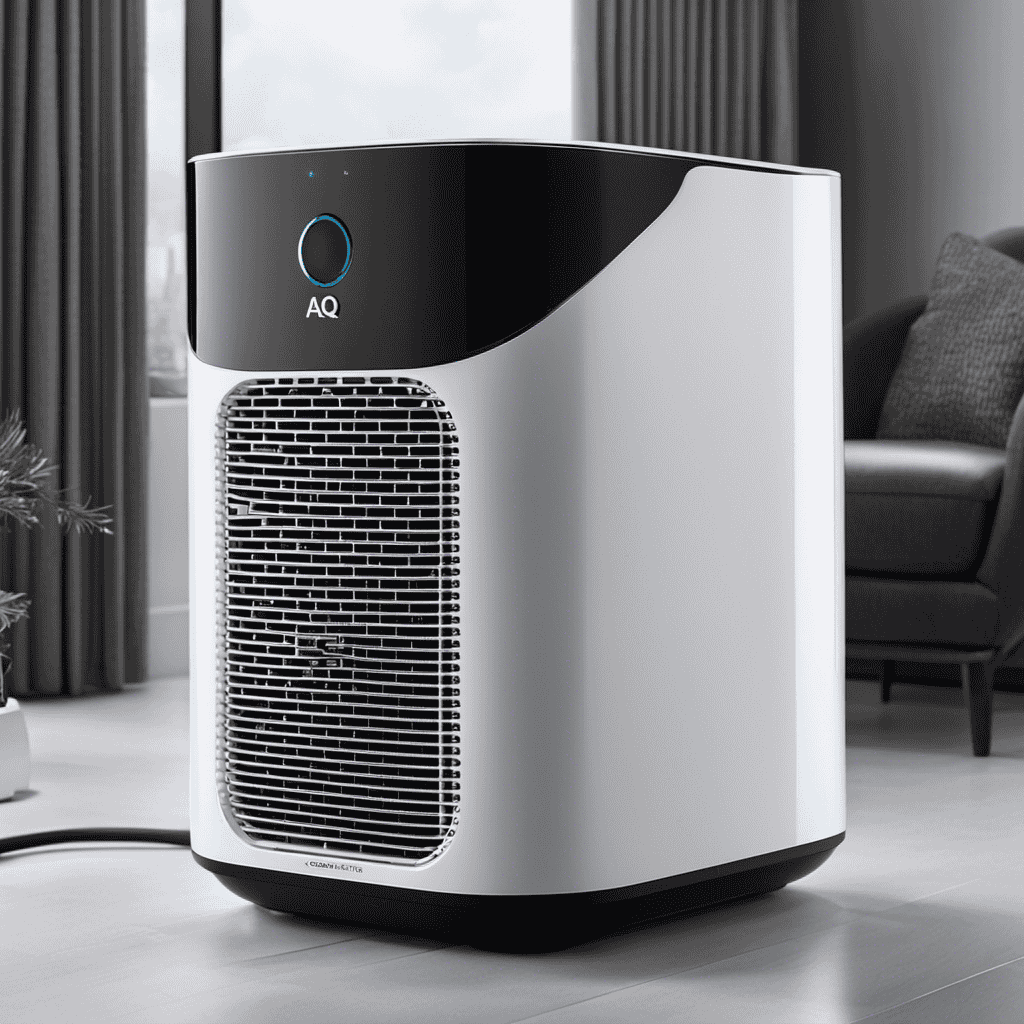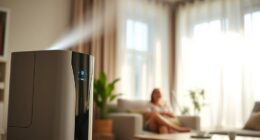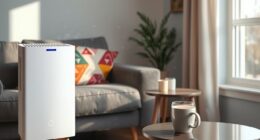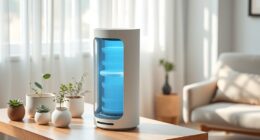As someone who owns an air purifier, I often question the frequency at which I should replace the filter to guarantee optimal performance. This article will delve into the different factors that impact the longevity of air purifier filters, as well as the unmistakable signs that signal it’s time for a filter replacement.
Additionally, we will provide recommended filter change frequencies for different types of air purifiers and offer tips on how to extend the lifespan of your filter.
So, let’s dive in and discover the proper way to replace and maintain your air purifier filter.
Key Takeaways
- The quality of the air purifier filter and the air quality in the environment can impact the filter’s lifespan.
- Signs that indicate the need for a filter change include reduced airflow, visible buildup of dirt or dust on the filter, unpleasant odors, and an illuminated indicator light on the air purifier.
- The recommended filter change frequency varies for different types of air purifiers, so it’s important to consult the manual or built-in filter change reminders.
- Regular maintenance and proper cleaning techniques can extend the lifespan and effectiveness of the air purifier filter.
Factors Affecting Filter Lifespan
To make your filter last longer, you should avoid smoking or using air purifiers in dusty environments. There are several factors that can affect the performance and lifespan of your air purifier filter.
The first factor is the initial quality of the filter itself. High-quality filters are designed to trap smaller particles and last longer compared to lower quality filters.
Another factor is the air quality in your environment. If you live in an area with high levels of pollution or allergens, your filter will have to work harder to clean the air, which can shorten its lifespan.
Additionally, the frequency of use plays a role in filter lifespan. If you run your air purifier constantly, the filter will accumulate more particles and require more frequent changes.
Finally, proper maintenance and cleaning of the filter can also impact its longevity. Regularly cleaning or replacing pre-filters can help prevent clogging and extend the lifespan of the main filter.
Understanding these factors and taking steps to minimize their impact can help ensure that your air purifier filter lasts as long as possible. Now let’s explore the signs that indicate your air purifier filter needs changing.
Signs That Your Air Purifier Filter Needs Changing
If the indicator light is on, it’s time to replace your air purifier’s filter. Keeping your air purifier’s filter clean is essential for maintaining its effectiveness in removing pollutants from the air. Here are some signs that your air purifier filter needs changing:
-
Reduced Airflow: If you notice a decrease in the airflow coming from your air purifier, it could be a sign that the filter is clogged. A clogged filter restricts the flow of air, reducing the purifier’s efficiency.
-
Visible Dirt or Dust: Take a look at your filter and see if there is a visible buildup of dirt or dust. This accumulation indicates that the filter is no longer effectively capturing particles and needs to be replaced.
-
Unpleasant Odors: If your air purifier starts emitting unpleasant odors, it could be a sign that the filter is saturated with pollutants. A clogged filter cannot effectively eliminate odors, and it’s time for a replacement.
Regularly cleaning your air purifier filter is crucial to maintaining its performance. Consult your air purifier’s manual for specific cleaning instructions. In general, most filters can be cleaned by gently vacuuming or rinsing with water. However, it is important to note that not all filters are washable, so be sure to check your manufacturer’s recommendations.
Recommended Filter Change Frequency for Different Types of Air Purifiers
In this discussion, I will be exploring the optimal filter change frequency for different types of air purifiers, as well as the factors that can affect the lifespan of these filters.
It is important to understand how often filters should be replaced in order to maintain the effectiveness of your air purifier and ensure clean and healthy air in your space.
Additionally, by identifying the factors that can impact filter lifespan, we can take proactive measures to extend the longevity of our filters and ultimately save on replacement costs.
Optimal Filter Change Frequency
You should regularly check and change the filter on your air purifier to ensure optimal performance. Here are some key reasons why regular filter changes are important:
-
Filter Change Reminders: Many air purifiers have built-in filter change reminders that notify you when it’s time to replace the filter. These reminders help you stay on top of filter maintenance and ensure that your air purifier continues to work effectively.
-
Benefits of Regular Filter Changes: Improved Air Quality: Changing the filter regularly helps remove airborne particles such as dust, pollen, pet dander, and mold spores, leading to cleaner and healthier air in your home.
Enhanced Performance: A clean filter allows the air purifier to function at its best, ensuring maximum efficiency in capturing pollutants and maintaining optimal airflow.
Prolonged Lifespan: Regular filter changes prevent the accumulation of dirt and debris, reducing strain on the air purifier’s motor and extending its lifespan.
Factors Affecting Filter Lifespan
Regular maintenance and cleaning of your air purifier can significantly extend the lifespan of the filter.
There are several factors that can affect the performance of your air purifier’s filter. One important factor is the quality of the air in your environment. If you live in an area with high levels of pollutants, such as dust, pet dander, or smoke, your filter will need to work harder and may need to be replaced more frequently.
Another factor is the usage of the air purifier. If you run it constantly or at higher speeds, the filter will accumulate more debris and particles, leading to a shorter lifespan.
Regular filter maintenance, such as vacuuming or washing, can help remove trapped particles and prevent clogging.
Extending the Lifespan of Your Air Purifier Filter
I’ve learned that prolonging the effectiveness of my air purifier filter is crucial for maintaining clean and healthy indoor air. To achieve this, I’ve discovered a few filter maintenance tips that have been incredibly helpful.
Regularly vacuuming the filter, washing it with mild soap and water, and allowing it to completely dry before reinserting it into the air purifier are some of the key practices that can significantly extend the lifespan of the filter and enhance its performance.
Filter Maintenance Tips
Changing the filter on your air purifier regularly is important for maintaining optimal performance. Here are some filter maintenance tips to help you keep your air purifier running efficiently:
-
Filter Cleaning Techniques:
-
Use a soft brush or vacuum attachment to remove dust and debris from the surface of the filter.
-
Rinse the filter with water to remove trapped particles, making sure to follow the manufacturer’s instructions.
-
Allow the filter to dry completely before reinstalling it in the air purifier.
-
DIY Filter Replacements:
-
Check the manufacturer’s guidelines to determine how often the filter should be replaced.
-
Purchase a compatible filter from a trusted source.
-
Follow the manufacturer’s instructions to safely replace the filter.
By regularly cleaning and replacing the filter, you can ensure that your air purifier continues to effectively remove pollutants from the air.
This will be discussed further in the next section on prolonging filter effectiveness.
Prolonging Filter Effectiveness
To maintain the effectiveness of your filter, it’s important to follow proper cleaning and replacement techniques. By extending the filter life, you can save money and ensure that your air purifier is continuously providing clean air. Here are some filter replacement tips to help you prolong the effectiveness of your filter:
| Filter Type | Recommended Replacement Frequency | Cleaning Method |
|---|---|---|
| HEPA | Every 6-12 months | Vacuum |
| Carbon | Every 3-6 months | None |
| Pre-filter | Every 1-3 months | Vacuum |
Regularly vacuuming the filters helps remove larger particles and debris, allowing them to capture finer particles more effectively. Additionally, some filters, like carbon filters, cannot be cleaned and must be replaced regularly. It’s important to follow the manufacturer’s recommendations for filter replacement to ensure optimal performance. By following these tips, you can extend the life of your filter and maintain the efficiency of your air purifier.
How to Properly Replace the Filter in Your Air Purifier
When replacing the filter in your air purifier, make sure to follow these steps for proper installation. It is crucial to maintain the efficiency and effectiveness of your air purifier by regularly replacing the filter. Here is a step-by-step filter replacement guide to help you troubleshoot your air purifier filters:
-
Turn off the air purifier and unplug it from the power source.
-
Locate the filter compartment. It is usually located at the back or side of the air purifier.
-
Open the compartment by removing any screws or latches.
- Some air purifiers have a filter indicator light that will alert you when it’s time to change the filter.
- Refer to the user manual for specific instructions on how to access the filter compartment.
- Take note of the filter size and type before purchasing a replacement.
-
Remove the old filter by carefully sliding it out of the compartment.
-
Dispose of the old filter properly.
-
Insert the new filter into the compartment, making sure it fits securely.
-
Close the compartment and fasten any screws or latches.
-
Plug in the air purifier and turn it on to ensure proper installation.
Common Mistakes to Avoid When Changing Air Purifier Filters
One common mistake to avoid is not properly disposing of the old filter after replacing it in your air purifier. When changing air purifier filters, it is crucial to follow the correct disposal procedures to ensure the best performance of your device. Improper disposal can lead to the accumulation of dust and allergens, reducing the effectiveness of your air purifier and compromising the air quality in your home.
Another mistake to avoid is not replacing the filter at the recommended intervals. Regularly changing air purifier filters is essential to maintain optimal performance and ensure clean, fresh air. Over time, filters become clogged with particles, reducing airflow and efficiency. By following the manufacturer’s guidelines, you can prevent this issue and enjoy the benefits of improved air quality.
Additionally, failing to clean the air purifier regularly can hinder its functionality. Dust and debris can accumulate on the device, obstructing airflow and diminishing its effectiveness. It is crucial to clean the exterior and interior components, such as fans and vents, to maintain proper functioning.
Frequently Asked Questions
Can I Clean and Reuse the Air Purifier Filter Instead of Replacing It?
Yes, you can clean and reuse air purifier filters, but it’s not recommended. Regularly replacing the filter is more beneficial for maintaining optimal air quality.
Cleaning the filter may not effectively remove all contaminants and can reduce the filter’s efficiency. Reusing filters can also lead to a buildup of dirt and pollutants, which can negatively impact the air purifier’s performance.
Therefore, it’s best to follow the manufacturer’s recommendations and replace the filter as suggested.
What Happens if I Don’t Change the Air Purifier Filter as Recommended?
If I don’t change the air purifier filter as recommended, there are risks and consequences.
When the filter is not replaced regularly, it becomes clogged with dirt, dust, and debris. This decreases the air purifier’s efficiency and effectiveness in removing pollutants from the air.
Additionally, a dirty filter can lead to poor air quality, which can cause respiratory issues and allergies.
It is crucial to follow the manufacturer’s guidelines and change the filter as instructed to maintain a healthy indoor environment.
Are There Any Special Considerations for Changing the Filter in a Portable Air Purifier Versus a Whole-House Unit?
When it comes to changing the filter in a portable air purifier versus a whole-house unit, there are some special considerations to keep in mind.
Firstly, reusable air purifier filters require regular cleaning to ensure optimal performance. This involves following the manufacturer’s instructions for proper maintenance.
Additionally, when disposing of air purifier filters, it is important to check local regulations and guidelines to ensure proper disposal methods are followed. This helps to minimize environmental impact and maintain the effectiveness of the air purifier.
Can Using a Higher Quality Filter Extend the Lifespan of the Air Purifier?
Using aftermarket filters can greatly benefit the lifespan of your air purifier. Regularly changing the filter is essential for maintaining optimal performance.
Higher quality filters can capture more particles, improving indoor air quality and reducing strain on the purifier’s motor.
Depending on the air quality and usage, it’s recommended to change the filter every three to six months. This ensures efficient filtration and prolongs the life of your air purifier, saving you money in the long run.
Is It Necessary to Change the Pre-Filter and Carbon Filter Along With the Main Filter?
Yes, it’s necessary to change the pre-filter and carbon filter along with the main filter on an air purifier.
The pre-filter captures larger particles, like dust and pet hair, while the carbon filter removes odors and harmful gases.
By replacing all the filters regularly, you ensure that your air purifier continues to effectively filter the air.
When disposing of used air purifier filters, check with your local recycling center for proper disposal methods.
What is the Recommended Frequency for Changing Filters on Air Purifiers in General?
The recommended frequency for changing Hunter air purifier filters depends on usage. For typical usage, it’s suggested to change the filter every 6-12 months. However, if the air purifier is used in a high-traffic area or a home with pets, more frequent changing of the Hunter air purifier filter may be necessary.
Conclusion
In conclusion, maintaining clean air in our homes is crucial for our health and well-being.
One interesting statistic to keep in mind is that, according to experts, the average lifespan of an air purifier filter ranges from 6 months to 2 years, depending on various factors such as air quality and usage.
By regularly checking and replacing our air purifier filters as recommended, we can ensure that our air purifiers continue to effectively remove pollutants and allergens from our indoor environment, providing us with clean and fresh air to breathe.
